Search results for: 'form'
-
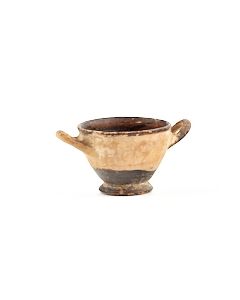 Greek skyphos
Greek skyphosNicely preserved piece from an old German private collection. Acquired 1978 at Davies Antiques Gallery, London.
Price: on request Socketed axe head with colourful patina
Socketed axe head with colourful patinaKörper mit ovalem Querschnitt und charakteristischer Öffnung am Nacken, für die einfache Schäftung des Beilkopfes. Derartige Beile wurden in der späten Bronzezeit als Arbeitsgeräte vielfältig eingesetzt. Spannendes Belegstück.
Price: on request Großes Skarabäussiegel aus der Zeit des Amenophis III.
Großes Skarabäussiegel aus der Zeit des Amenophis III.14. Jh. v. Chr. Heute noch erhaltene Überreste der Bautätigkeit Amenophis III. sind die Memnonkolosse, sowie der Hauptteil des Luxor-Tempels.
Price: on request Römische Fibel
Römische FibelTyp der Kräftig Profilierten Fibeln, 2. Jh. n. Chr. bis 4. Jh. n. Chr., Guter Zustand, schöne Patina. Fund aus Region der Limeskastelle Pförring, Eining, Pfünz, Kösching und Weißenburg.
Price: on request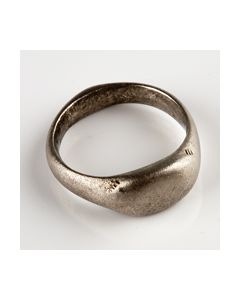 Römischer Ring aus Silber
Römischer Ring aus SilberRömische Kaiserzeit, möglicherweise aus der keltischen Provinz oder Provinznähe. Ringband geht nahtlos in die Ringplatte über. Theoretisch auch heute noch als Amulett oder Fingerring tragbar. Innendurchmesser 17mm bis 18mm.
Price: on request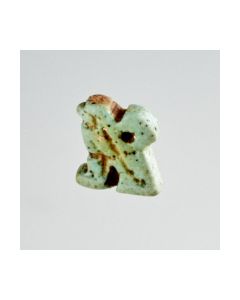 Egyptian amulet of a falcon
Egyptian amulet of a falconThe falcon in Egyptian art can be a depiction of the god Horus or symbolize the soul of the pharao. Falcon amulets are known from the earliest times in Egyptian history. However this speicmen dates to the Late Dynastic Period of Ancient Egypt.
Price: on request Hand axe from Galilee
Hand axe from GalileeBig paleolithic hand axe. The universal stone age tool could be use as a borer or cutting tool. Around 500,000 to 200,000 BC.
Price: on request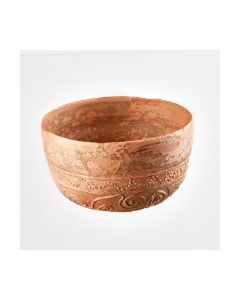 Megarian bowl with floral decoration
Megarian bowl with floral decorationNicely preserved piece from a private Columbus (Ohio, USA) collection
Price: on request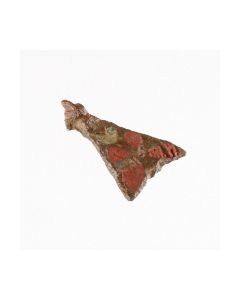 Roman cicada brooch
Roman cicada broochBrooch in the shape of an insect. Popular type in the northern Roman provinces during the 2nd century.
Price: on request Roman bronze jar
Roman bronze jarMassive piece with beautiful ram head shaped handle, 1st-2nd century AD
Price: on request Roman jug made of aubergine glass
Roman jug made of aubergine glassBeautiful glass with a violet colour. From the Roman Imperial period.
Price: on request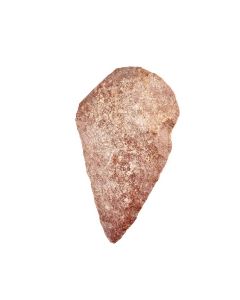 Paleolithic hand axe
Paleolithic hand axeThe universal tool of the older Stone age. It could be used as a borer or a cutter. Approx. 500,000 to 200,000 BC.
Price: on request Painted Bronze Age cup
Painted Bronze Age cupThe well preserved Bronze Age pottery bears a geometric painted pattern. Acquired in 1977 at Davies Antiques in London, it is claimed to have been found in Syria.
Price: on request Bronze ornaments with goddess of victory
Bronze ornaments with goddess of victoryMatching pair of appliques that were once soldered to a Roman vessel. They show the goddess of victory, Victoria.
Price: on request Skarabäussiegel mit abstaktem Stempelmotiv
Skarabäussiegel mit abstaktem StempelmotivDie Stempelfläche trägt ein dekoratives Muster mit ästhetischer oder magischer Funktion. Sehr schöner und anschaulicher Skarabäus, in etwa aus der Zweiten Zwischenzeit des Alten Ägyptens. 2000 bis 1300 v. Chr.
Price: on request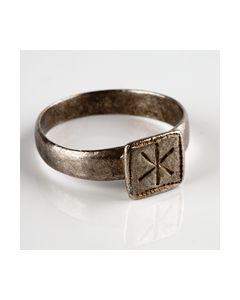 Byzantinischer Fingerring mit vereinfachtem Christusmonogramm
Byzantinischer Fingerring mit vereinfachtem ChristusmonogrammFingerring aus Silber. Ringplatte mit von einer punzierten Linie gerahmtem Feld. Darin ein vereinfachtes Christusmonogramm, Chi-Rho. 6. bis 8 Jh. n. Chr.
Price: on request Roman oil lamp showing Sol-Helios
Roman oil lamp showing Sol-HeliosInteresting transition type to the so-called North African oil lamps. Nicely preserved, unusual piece.
Price: on request Impressive Roman imperial bronze oil lamp
Impressive Roman imperial bronze oil lampBeautiful patina, very well preserved. With large leaf-shaped handle. Dating to 1st - 2nd century AD.
Price: on request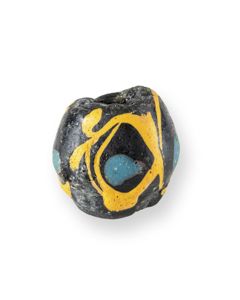 Glass bead with polychrome decoration
Glass bead with polychrome decorationLarge bead made of opaque dark blue glass decorated with yellow lines and light blue eyes.
Price: on request Egyptian amulet of Shu
Egyptian amulet of ShuGod of the air and the sun. The highly stylized figurine shows the ancient Egyptian god on his knees, the arms raised towards the sun. From a British private museum.
Price: on request Egyptian amulet of Shu
Egyptian amulet of ShuGod of the air and the sun. The highly stylized figurine shows the ancient Egyptian god on his knees, the arms raised towards the sun. From a British private museum.
Price: on request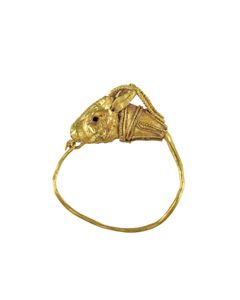 Hellenistic gold earring with antelope head
Hellenistic gold earring with antelope headEar pendant with plastically modeled head of an antelope. The elaborately made head is typical for hellenistic gold jewellery.
Price: on request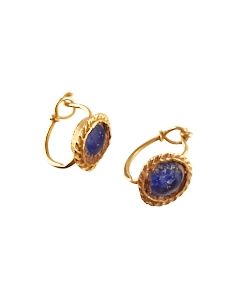 Pair of Roman gold earrings
Pair of Roman gold earringsNice golden earrings with blue glass inserts from late Roman Imperial times. It is a belonging pair of earrings which is in itself a rarity.
Price: on request Large decorated violin bow fibula
Large decorated violin bow fibulaImpressive piece of jewellery because of its size and decoration. From Central Europe, made during Late Bronze Age or Early Iron Age.
Price: on request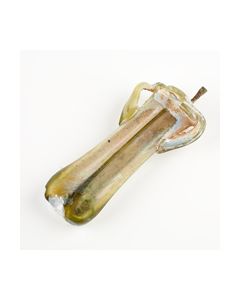 Very rare Roman glass double unguentarium with applicator
Very rare Roman glass double unguentarium with applicatorPerfectly preserved, worth the exhibition in a museum. From an old British collection.
Price: on request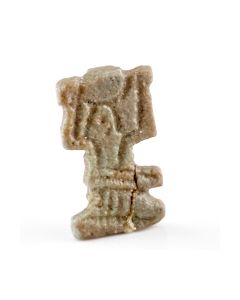 Amulett des Gottes Schu
Amulett des Gottes SchuDer ägyptische Gott Schu wurde u.a. mit der Hitze des Sonnenlichts assoziiert. Das Amulett zeigt ihn kniend, mit der Sonnenscheibe zwischen den erhobenen Armen. Aus der Spätzeit des Alten Ägyptens.
Price: on request Roman surgical probe made of silver
Roman surgical probe made of silverThe so-called specillum was standard issue for roman doctors. Similar probes are still in use today. Ancient surgical instruments made of silver are extremely rare.
Price: on request Roman ribbed glass bowl
Roman ribbed glass bowlOf beautiful, thick-walled glass of a bright light green color. The glass was mold made in a Roman factory of the eastern Mediterranean.
Price: on request Oil lamp with Amphitheater scene, piece from same workshop exhibited in Getty Museum in LA
Oil lamp with Amphitheater scene, piece from same workshop exhibited in Getty Museum in LAThe mirror scene probably depicts the persecution of Christians in the Roman Empire. Very nicely preserved, from an old US-American collection. Ex Christie's.
Price: on request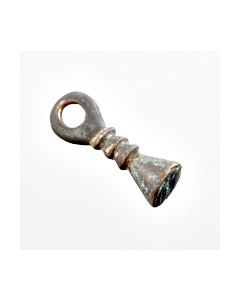 Western Iranian bronze stamp seal
Western Iranian bronze stamp sealInteresting bronze seal showing a bird and glyphs. From a collection of Iranian ancient artefacts.
Price: on request Decorative pin from Luristan
Decorative pin from LuristanThe pin head is shaped like an open basket with a decorative knob. Bronze with attractive patina.
Price: on request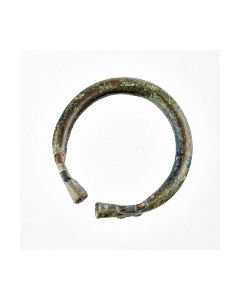 Bracelet from Luristan with animal terminals
Bracelet from Luristan with animal terminalsA high degree of abstraction for the animal heads and a wonderful blue patina make this piece a highlight for Iranian bronze works.
Price: on request Etruscan red figure Kylix
Etruscan red figure KylixThe tondo shows an elaborate depiction of two men. From an old German private collection, acquired 1979 at René Gott gallery, Geneva. Coming with an ArtLoss certificate
Price: on request Statue of Ptah-Sokar-Osiris
Statue of Ptah-Sokar-OsirisThe wooden statue represents the ancient Egyptian funerary deity Ptah-Sokar-Osiris. It was made in Egypt's Late Period, 7th to 4th century BC.
Price: on request Beilkopf aus der Jungsteinzeit
Beilkopf aus der JungsteinzeitKlinge eines dünnblattigen Dicknackenbeils. Trapezförmiger Körper mit grob bearbeiteten Seiten. Ganggrabzeit bis Dolchzeit.
Price: on request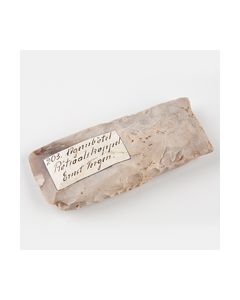 Flaches Rechteckbeil der Trichterbecherkultur
Flaches Rechteckbeil der TrichterbecherkulturAlle Seiten fein bearbeitet, jedoch nur die Schneide poliert. Flache, dünnnackige Klinge. Gefunden um 1900 in Negernbötel, Schleswig-Holstein.
Price: on request

